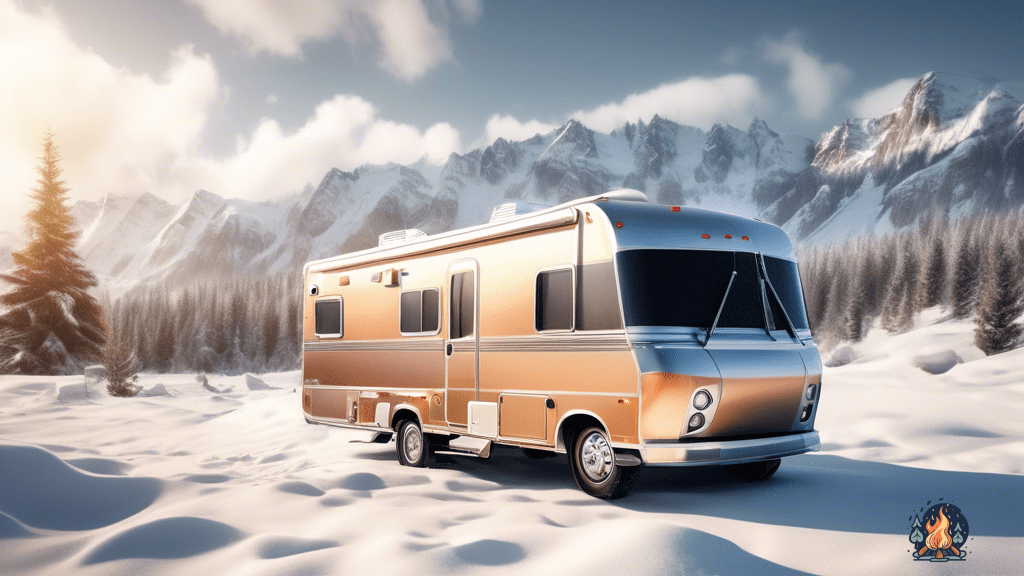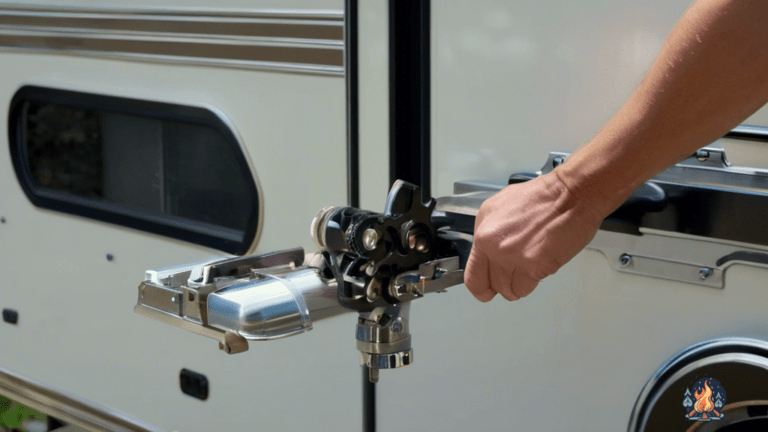A Comprehensive Guide To RV Winterization For Beginners
by Kevin Fairbanks • Updated: January 21, 2024
Protect your RV this winter with our comprehensive guide! Learn how to properly winterize your vehicle and keep it in top shape. Don’t miss out on the essential tips and tricks for beginners. Get started now!

Are you a beginner in the world of RVing and feeling a bit overwhelmed about how to prepare your RV for the winter season? Well, fear not, my friend, because this comprehensive guide to RV winterization is here to help you out!
Winterizing your RV is not only important for protecting it from the harsh cold weather, but it’s also crucial for ensuring that your RV is ready to hit the road again when the warmer days come back around.
So, grab a cup of hot cocoa, sit back, and let’s dive into the wonderful world of RV winterization together!
Now, I know what you’re thinking – winterizing an RV sounds like a daunting task, right? But trust me, with the right knowledge and a little bit of humor, you’ll be a pro in no time!
In this guide, we’ll cover everything from preparing your water system for the cold weather to insulating and sealing your RV, and even protecting its exterior.
We’ll also talk about the best practices for storing your RV during the winter season, ensuring that it stays in tip-top shape until your next adventure.
So, whether you’re a newbie or a seasoned RVer looking for some fresh tips, get ready to embark on this winterization journey with a smile on your face and a warm heart!
Understanding the Importance of RV Winterization
Now that you understand the basics of RV maintenance, it’s time to dive into the importance of winterization – like a warm blanket protecting you from the bitter cold, proper winterization ensures your RV stays safe and in top condition during the freezing winter months.
Picture this: it’s a cold winter day, snow falling gently outside, and you’re all cozied up inside your RV, sipping hot cocoa by the fireplace. Sounds like a dream, right? Well, without proper winterization, that dream can quickly turn into a nightmare. Winter brings freezing temperatures, snow, and ice, all of which can wreak havoc on your beloved RV. From frozen pipes to cracked seals, the potential for damage is as real as trying to catch snowflakes on your tongue.
But fear not, my fellow RVer, for winterization is here to save the day!
Winterization is like giving your RV a warm, snug sweater to protect it from the harsh elements. It involves a series of steps to properly prepare your RV for the winter season. Just like you wouldn’t go outside in the freezing cold without a coat, your RV shouldn’t face the winter without proper protection.
By winterizing your RV, you’re ensuring that its vital systems, such as the plumbing and water lines, are safeguarded from the freezing temperatures. It’s like giving your RV a little spa day, pampering it and making sure it’s in tip-top shape for the winter hibernation.
So, grab your winterization checklist and get ready to show Old Man Winter who’s boss!
Preparing Your Water System for Cold Weather
To ensure your water system remains functional in freezing temperatures, it’s important to properly prepare it for cold weather. Here are a few tips to help you get started:
- Drain and flush your water tanks: Before the temperatures drop, make sure to drain and flush your water tanks thoroughly. This will help remove any remaining water and prevent it from freezing and causing damage to your system. Remember to open all faucets and drains to ensure that all the water is completely drained.
- Insulate your pipes: Just like you, your pipes also need a little extra warmth during the cold winter months. Insulating your pipes with foam or heat tape can help prevent them from freezing. This simple step can save you from the headache of dealing with burst pipes and costly repairs.
- Use RV antifreeze: RV antifreeze is a great way to protect your water system from freezing. Before storing your RV for the winter, thoroughly flush your system with antifreeze. This will help ensure that any remaining water in your pipes and tanks won’t freeze and cause damage. Just make sure to use antifreeze specifically designed for RVs, as regular antifreeze can be toxic if consumed.
Remember, taking the time to properly prepare your water system for cold weather can save you from costly repairs and headaches down the road. So grab your tools and get ready to winterize like a pro!
Insulating and Sealing Your RV
Ensure your RV stays cozy and warm during the winter months by insulating and sealing all the cracks and gaps. This will not only help keep the cold air out, but it will also prevent any unwanted critters from making their way inside. Start by inspecting your RV for any cracks or gaps that need to be sealed. Pay special attention to areas around windows, doors, vents, and any other openings. Use caulk or weatherstripping to seal these areas and keep the cold air out. Don’t forget to check the roof as well! A leaky roof can lead to water damage and a chilly interior. Apply a layer of sealant to any areas that may be prone to leaks.
Once you have sealed all the cracks and gaps, it’s time to insulate your RV. Insulation helps to keep the heat inside and the cold air out. One of the most effective ways to insulate your RV is by using foam insulation. This can be applied to the walls, floor, and ceiling to provide maximum insulation. Another option is to use thermal curtains or window insulation film. These can be hung over windows and doors to help keep the cold air out. Finally, don’t forget about your pipes! Insulate them with pipe insulation or heat tape to prevent them from freezing.
To help you stay organized, here’s a handy table to keep track of all your insulation and sealing tasks:
| Area to Insulate/Seal | Materials Needed | Task Completed? |
|---|---|---|
| Windows | Caulk/Weatherstripping | |
| Doors | Caulk/Weatherstripping | |
| Vents | Caulk/Weatherstripping | |
| Roof | Sealant | |
| Walls | Foam Insulation | |
| Floor | Foam Insulation | |
| Ceiling | Foam Insulation | |
| Pipes | Pipe Insulation/Heat Tape |
Remember, a well-insulated and sealed RV is a happy RV. So grab your materials, put on your DIY hat, and get to work!
Protecting Your RV’s Exterior
When winterizing your RV, it’s important to take steps to protect its exterior. After all, you want your RV to look as good as new when the snow melts and the birds start chirping again.
One of the first things you should do is give your RV a thorough cleaning. Get out the soap and water and scrub away all the dirt and grime that has accumulated over the summer. And don’t forget to wash the roof too! You don’t want any pesky leaves or branches causing damage during the winter months.
Once your RV is squeaky clean, it’s time to apply a protective wax. Think of it like giving your RV a nice, cozy sweater to wear during the cold weather. Plus, a little extra shine never hurt anyone. So grab your waxing cloth and get to work! Your RV will thank you later.
Now that your RV is all cleaned up and protected, it’s time to think about its vulnerable areas. No, I’m not talking about its feelings. I’m talking about the tires! Those round rubber things that keep your RV rolling. You definitely don’t want them to freeze up or get damaged during the winter.
So, make sure to check the tire pressure and inflate them to the recommended level. And while you’re at it, why not cover them with tire covers? It’s like giving them a warm, fuzzy blanket to snuggle up with. Trust me, your tires will appreciate the extra TLC.
Lastly, don’t forget about the windows and doors. They may seem small, but they can let in a whole lot of cold air if not properly sealed. So, grab some weatherstripping tape and seal up any gaps or cracks. Your RV will be as snug as a bug in a rug, and you’ll have peace of mind knowing that it’s protected from the harsh winter elements.
Storing Your RV for the Winter Season
First, make sure you find a suitable location for storing your RV during the winter season. You don’t want your precious RV to be left out in the cold, do you? Look for a place that offers protection from the elements, like a covered storage facility or a sturdy garage.
Here are a few things to consider when choosing a storage location:
- Find a place that has good security measures in place. You don’t want any unwanted guests snooping around your RV. Look for facilities that have security cameras, gated access, and maybe even a guard dog named Spike.
- Make sure the storage location is easily accessible. You don’t want to have to go on a treacherous journey just to check on your RV. Look for a place that is conveniently located and has easy entry and exit points.
- Consider the size of the storage space. You don’t want to squeeze your RV into a space that is too small. Look for a location that offers ample room for your RV to be stored comfortably.
- Check if the storage location offers any additional services. Some places might offer services like battery charging, winterizing, or even RV maintenance. It’s like a spa for your RV!
- Lastly, consider the overall vibe of the storage facility. You want a place that feels safe and welcoming. Look for a location that has friendly staff, a sense of community, and maybe even a little RV-themed decor to make you feel right at home.
Now that you’ve found the perfect storage location for your RV, you can rest easy knowing that it will be safe and snug during the winter season. Happy RV hibernation!
Frequently Asked Questions
Can I use antifreeze in my RV’s freshwater tank during winterization?
Yes, you can use antifreeze in your RV’s freshwater tank during winterization. However, imagine the horror of accidentally sipping on a frosty concoction of antifreeze! So, be cautious and ensure proper flushing before using the tank again.
How often should I check the tire pressure of my RV during the winter season?
You should check your RV’s tire pressure at least once a month during the winter season. Just like your waistline after the holidays, tire pressure can fluctuate. Keep those tires properly inflated, buddy!
Are there any specific maintenance tasks I should do before storing my RV for the winter?
Before storing your RV for the winter, make sure to empty and clean all tanks, remove perishable items, disconnect the battery, and cover it up. Don’t forget to give it a heartfelt goodbye hug!
Can I leave food items inside the RV during the winter storage period?
Of course you can leave food items inside your RV during winter storage! Who doesn’t love the surprise of finding moldy bread and expired canned goods when they finally take their RV out of hibernation? It’s like a culinary adventure!
Is it necessary to remove the battery from my RV during winter storage?
Yes, it’s a good idea to remove the battery from your RV during winter storage. Freezing temperatures can wreak havoc on batteries, leaving you with a dead one come spring. Give it a vacation too!

Hi, I’m Kevin, a lifelong camping enthusiast and the voice behind Campfire Discoveries. From tent to RV to cabin camping, I’ve explored it all. Join me as we share stories and tips around the campfire, deepening our connection with the great outdoors.
Keep Reading
-
Essential RV Slideout Maintenance Tips For Beginners
Keep your RV slideouts in top shape with these essential maintenance tips. Don’t let costly repairs ruin your journey – click here to start your RV adventure on the right foot!
-
Illuminating Your Camping Experience: Tents With Built-In Lights
Upgrade your camping experience with tents featuring built-in lights. Illuminate your nights and make memories that shine. Click now for illuminating tips and recommendations on the best tent with built-in lights for your next adventure!
-
Cool Off At RV Parks With Inviting Pools
Escape the summer heat and dive into relaxation at RV parks with inviting pools. Discover the ultimate getaway and make a splash today! Find your perfect spot for fun in the sun at RV Parks with Pool.



